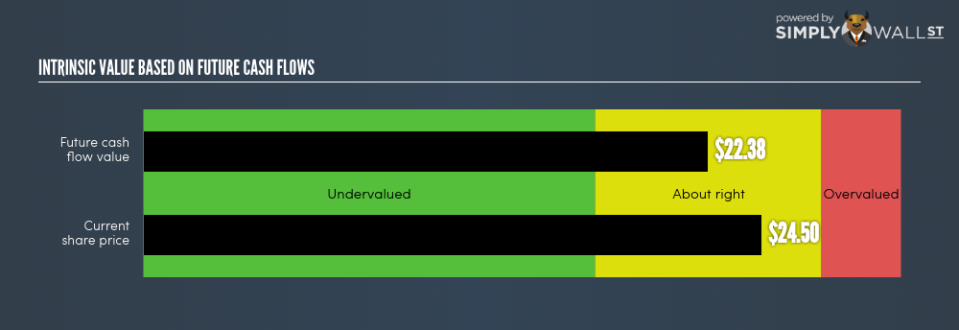Is Sterling Bancorp (NYSE:STL) Worth US$024.5 Based On Intrinsic Value?

STL operates in the banking industry, which has characteristics that make it unique compared to other sectors. Understanding these differences is crucial when it comes to putting a value on the bank stock. The tiered capital structure is common for banks to abide by, in order to ensure they maintain a sufficient level of cash for their customers. Looking at elements such as book values, in addition to the return and cost of equity, may be useful for evaluating STL’s true value. Below I will take you through how to value STL in a reasonably effective and simple way. Check out our latest analysis for Sterling Bancorp
What Model Should You Use?
Before we begin, remember that financial stocks differ in terms of regulation and balance sheet composition. United States’s financial regulatory environment is relatively strict. Moreover, banks tend to not have significant portions of physical assets on their books. As traditional valuation models put weight on inputs such as capex and depreciation, which is less meaningful for finacial firms, the Excess Return model places importance on forecasting stable earnings and book values.
Deriving STL’s True Value
The central belief for this model is, the value of the company is how much money it can generate from its current level of equity capital, in excess of the cost of that capital. The returns in excess of cost of equity is called excess returns:
Excess Return Per Share = (Stable Return On Equity – Cost Of Equity) (Book Value Of Equity Per Share)
= (10.53% – 9.96%) x $20.69 = $0.12
Excess Return Per Share is used to calculate the terminal value of STL, which is how much the business is expected to continue to generate over the upcoming years, in perpetuity. This is a common component of discounted cash flow models:
Terminal Value Per Share = Excess Return Per Share / (Cost of Equity – Expected Growth Rate)
= $0.12 / (9.96% – 2.95%) = $1.69
These factors are combined to calculate the true value of STL’s stock:
Value Per Share = Book Value of Equity Per Share + Terminal Value Per Share
= $20.69 + $1.69 = $22.38
This results in an intrinsic value of $22.38. Compared to the current share price of US$24.50, STL is , at this time, fairly priced by the market. This means there’s no real upside in buying STL at its current price. Valuation is only one part of your investment analysis for whether to buy or sell STL. Analyzing fundamental factors are equally important when it comes to determining if STL has a place in your holdings.
Next Steps:
For banks, there are three key aspects you should look at:
Financial health: Does it have a healthy balance sheet? Take a look at our free bank analysis with six simple checks on things like bad loans and customer deposits.
Future earnings: What does the market think of STL going forward? Our analyst growth expectation chart helps visualize STL’s growth potential over the upcoming years.
Dividends: Most people buy financial stocks for their healthy and stable dividends. Check out whether STL is a dividend Rockstar with our historical and future dividend analysis.
For more details and sources, take a look at our full calculation on STL here.
To help readers see pass the short term volatility of the financial market, we aim to bring you a long-term focused research analysis purely driven by fundamental data. Note that our analysis does not factor in the latest price sensitive company announcements.
The author is an independent contributor and at the time of publication had no position in the stocks mentioned.

